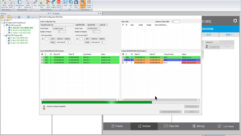A modern day corollary exists in today’s growing interest in using IP-based technology for professional audio-visual applications. This trend is in part due to perceived benefits in flexibility and performance and has resulted in packet-based transport being embedded into a wide variety of signal management products, regardless of whether or not AV over IP is the right tool for the job.
For applications requiring the extension and switching of high resolution video (UHD andt 4K) and KVM (keyboard, video, mouse) or those use cases where data security and integrity is a priority, AV over IP can fall short. This is not a temporary problem, rather it is due to the inherent limitations caused by the architecture of IP transport, which include:
Bandwidth: IP transport offers a standardized infrastructure, but one not designed with the bandwidth to move the large quantities of information found in today’s high-resolution video files. To get around this limitation, various levels of compression may be incorporated. This compression – and the delay caused by the process of compressing the signal at the source and uncompressing it at the destination — can degrade the image quality and introduce latency. For video-intensive applications in broadcast or missioncritical control rooms, this loss of resolution and performance is unacceptable.
Delay, Jitter and Judder: IP requires each packet to be analyzed prior to transmission across the network. This processing adds additional delay to data delivery. Also, variable packet delivery times can cause jitter and judder, which can further affect video quality and impact computer input device responsiveness in a KVM application. This deterioration becomes worse as the installation size increases.
Packet Reordering: IP packets may be transmitted over various network paths, and may arrive at their destination out of order. The process of reordering packets adds to the latency introduced by IP transport.
Security: For AV applications deployed in secure facilities with classified data, information assurance (IA) security standards restrict how confidential information is transported over an IP network, especially on a public or shared network. This restriction exists out of concern that IP data packets containing sensitive information could get lost or misdirected during transmission.
To address these concerns and meet the requirements of demanding, video-intensive AV applications, a 100 percent uncompressed stream based on a propriety multiplexing protocol is needed to insure signal integrity. This architecture provides the ability to extend and switch video and computer peripherals up to 80 km between sources and destinations, over a dedicated and inherently secure network, with no loss of signal quality.
The benefits of this alternative approach to AV over IP are multi-fold. The transported signal is completely unaltered, ensuring pixel-for-pixel integrity of the video signal and content, even at UHD and 4K resolutions. There is no perceptible delay or latency in either the video or audio signal or computer peripheral performance. This increases productivity and reduces user fatigue in content-intensive applications such as video editing or control room operations. For AV applications in mission-critical facilities, a dedicated KVM network that guarantees no alteration of the content through compression, possible loss of packets, or misdirection of packets through IP transmission, offers the highest level of security and signal integrity.
The benefits and savings of AV over IP KVM solutions must be justified by use case and to meet user expectations. For those mission-critical applications where uncompromised video resolution and system responsiveness are requirements, it may become necessary to put down the “hammer” and choose instead a more appropriate tool for the job.










